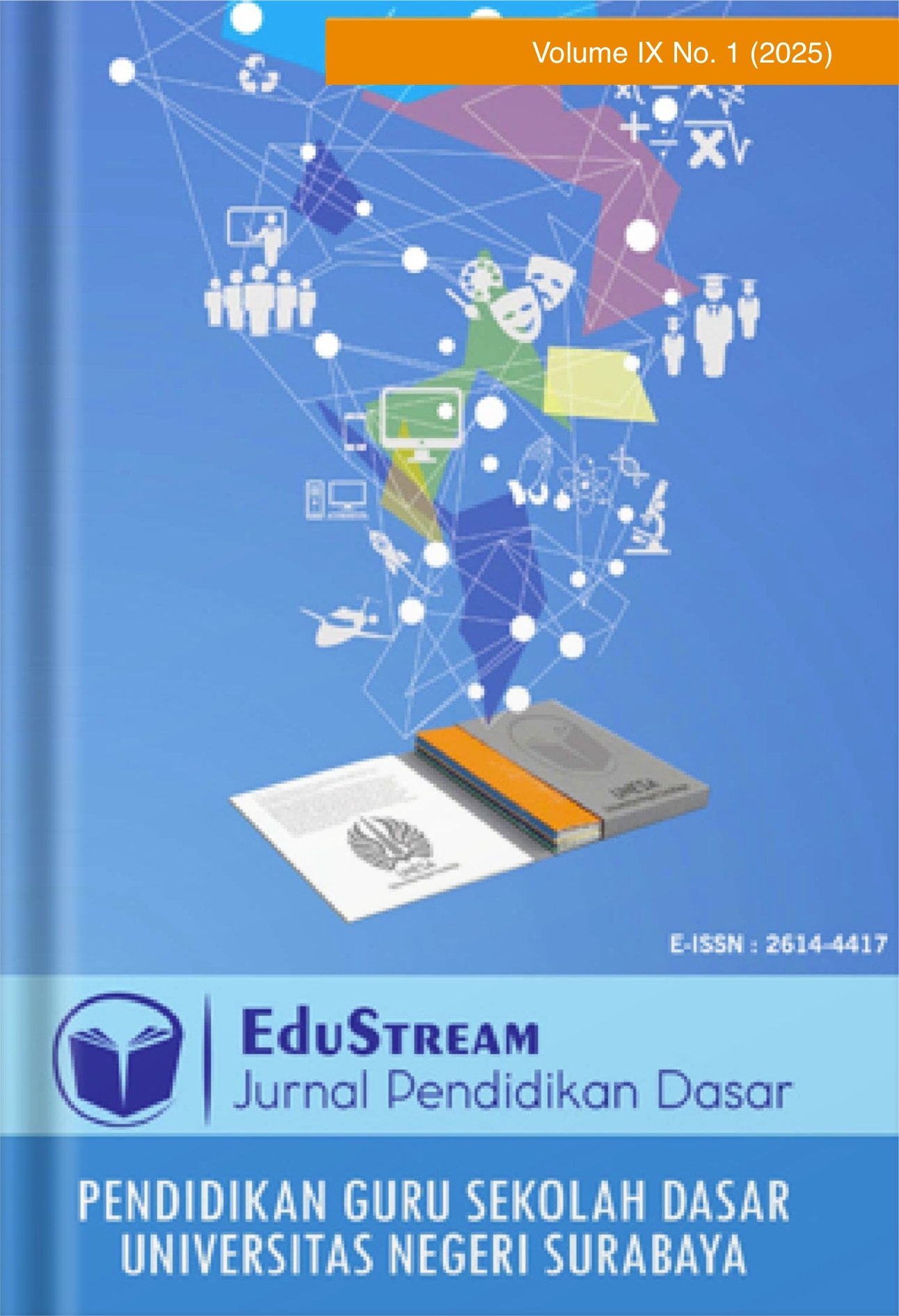The effect of digital media on elementary school students' ecoliteracy development
DOI:
https://doi.org/10.26740/eds.v9n1.p105-112Keywords:
Digital media, Ecoliteracy development, Elementary educationAbstract
This study aims to evaluate the effect of digital media use on the development of ecoliteracy of elementary school students. Digital media offers an interactive and interesting method way to deliver ecological concepts, that make students easy to understand the relationship between living things and the environment. This study used quantitative approach with a pre-experimental design of one group pretest-posttest design. The subjects of this study were fifth grade elementary school students in North Indralaya City, Indonesia. Data were collected through multiple-choice tests consisting of pretest and posttest, each consisting of 10 questions to measure students' abilities before and after treatment. The results of this study showed that the average pretest score was 44.28 and 80 in post-test, it was found that 17 students achieved the Minimum Completion Criteria after treatment. Hypothesis testing using the Paired Sample T-Test showed a significance of 0.000, which means there is a significant difference between the pretest and posttest scores. This study concludes that the use of digital media has a positive effect on the development of students' ecoliteracy, which can help them understand ecological concepts and increase environmental awareness
References
Abdullah, K. H. (2023). Eco-literacy and social media: A bibliometric review. Journal of Scientometric Research, 12(3), 631-640.
Antink-Meyer, A. (2023). K-8 Sustainability Education. In The Palgrave Handbook of Global Sustainability (pp. 1197-1211). Cham: Springer International Publishing.
Braun, T., Cottrell, R., & Dierkes, P. (2018). Fostering changes in attitude, knowledge and behavior: Demographic variation in environmental education effects. Environmental Education Research, 24(6), 899-920.
Burbules, N. C., Fan, G., & Repp, P. (2020). Five trends of education and technology in a sustainable future. Geography and sustainability, 1(2), 93-97.
Cannon, M. (2018). Digital media in education. Digital Media in Education, 12, 1-4.
Chu, E. W., & Karr, J. R. (2016). Environmental impact: Concept, consequences, measurement. Reference module in life sciences, B978-0.
Cutter-Mackenzie, A., & Smith, R. (2003). Ecological literacy: the ‘missing paradigm’in environmental education (part one). Environmental education research, 9(4), 497-524.
Demmans Epp, C., Phirangee, K., Hewitt, J., & Perfetti, C. A. (2020). Learning management system and course influences on student actions and learning experiences. Educational Technology Research and Development, 68(6), 3263-3297.
Engerman, J. A., & Otto, R. F. (2021). The shift to digital: designing for learning from a culturally relevant interactive media perspective. Educational Technology Research and Development, 69, 301-305.
Farid, M., Murtadho, N., Muslihati, M. A., Minghat, A. D., & Othman, N. (2024). Enhancing cultural inclusivity in primary schools: insights from Springer multicultural education data. Int. J. Eval. Res. Educ, 13(4), 2083-2094.
Kazazoglu, S. (2025). Environmental Education Through Eco-Literacy: Integrating Sustainability into English Language Teaching. Sustainability, 17(5), 2156.
McBride, B. B., Brewer, C. A., Berkowitz, A. R., & Borrie, W. T. (2013). Environmental literacy, ecological literacy, ecoliteracy: What do we mean and how did we get here?. Ecosphere, 4(5), 1-20.
Papademetriou, C., Anastasiadou, S., Konteos, G., & Papalexandris, S. (2022). COVID-19 pandemic: the impact of the social media technology on higher education. Education Sciences, 12(4), 261.
Pradita, L. E., Rachmawati, U., Ulyan, M. (2023). Buku Digital Berwawasan Lingkungan Sebagai Upaya Menumbuhkan Ekoliterasi Anak. Jurnal Obsesi: Jurnal Pendidikan Anak Usia Dini, 7(6), 7262-7276.
Putra, D. A., & Saputra, I. R. (2021). Peran Pendidikan Sekolah Dasar dalam Mengembangkan Ekoliterasi Anak-Anak. Jurnal Ilmu Pendidikan, 12(3), 45-56.
Rahma, R. A., Affriyenni, Y., & Widyaswari, M. (2021). Cybergogy as a Digital Media to Facilitate the Learning Style of Millennial College Students. World Journal on Educational Technology: Current Issues, 13(2), 223-235.
Syam, N., Hasnah, Syahreni. (2022). Pengaruh Model Pembelajaran Kooperatif Tipe Two Stay Two Stray Terhadap Hasil Belajar Siswa Tentang Siklus Air Kelas V UPTD SPF SD Negeri 51 Tonronge Kabupaten Soppeng. Juara SD: Jurnal Pendidikan dan Pembelajaran Sekolah Dasar (Vol. 1, No. 3).
Turner, K. H., Eisenstock, B., Hicks, T., Jolls, T., O’Byrne, W. I., Paciga, K. A., ... & Hagerman, M. S. (2024). The importance of digital media literacy. Handbook of Children and Screens, 541.
Tyas, D. N., Nurharini, A., Wulandari, D., & Isdaryanti, B. (2022). Analisis kemampuan ekoliterasi dan karakter peduli lingkungan siswa SD selama pembelajaran daring di masa pandemi COVID-19. Faktor: Jurnal Ilmiah Kependidikan, 9(3), 213-226.
Zhang, H., Zhu, C., Sang, G., & Questier, F. (2024). Effects of digital media literacy course on primary school students’ digital media literacy: an experimental study. International Journal of Technology and Design Education, 34(1), 1-17.
Downloads
Published
How to Cite
Issue
Section
License
Copyright (c) 2025 EduStream: Jurnal Pendidikan Dasar

This work is licensed under a Creative Commons Attribution-ShareAlike 4.0 International License.
Authors who publish with this journal agree to the following terms :
The articles published in this journal are protected by copyright. The copyright remains with the authors of the articles, but the publishing license is held by Universitas Negeri Surabaya as the journal manager. This license, Creative Commons Attribution-ShareAlike (CC BY-SA), allows readers to copy, distribute, and adapt the work, provided that proper attribution is given to the original author and any modified work is published under the same license. This license grants the freedom to use the work both commercially and non-commercially, as long as it adheres to the terms outlined in the license.
 Abstract views: 274
,
Abstract views: 274
, PDF Downloads: 274
PDF Downloads: 274

















